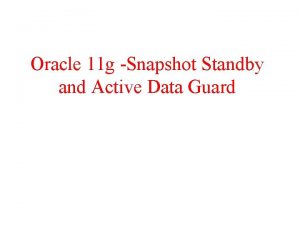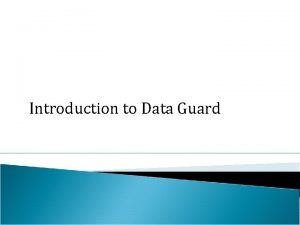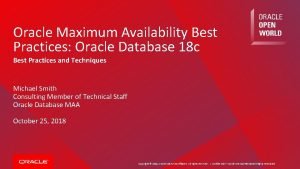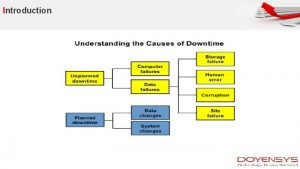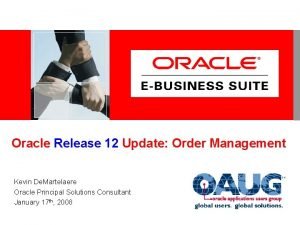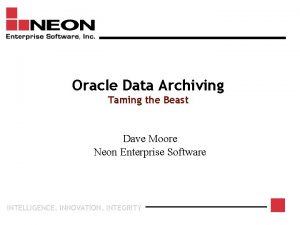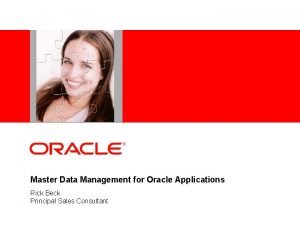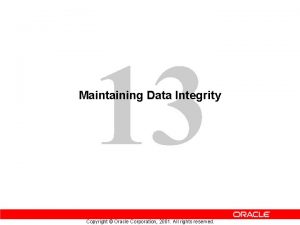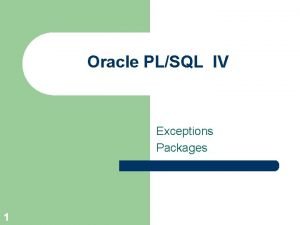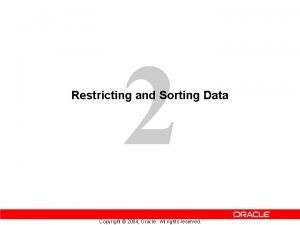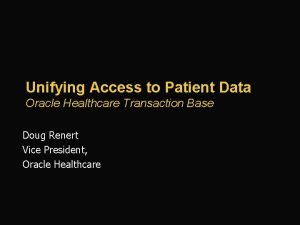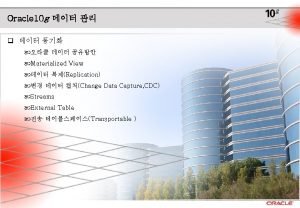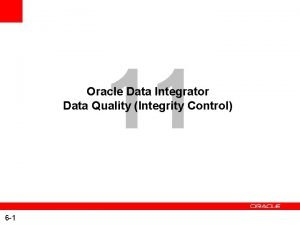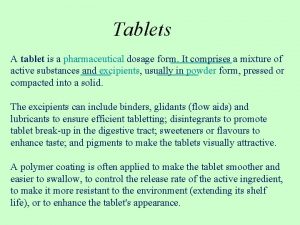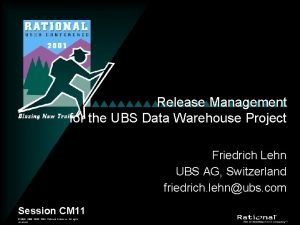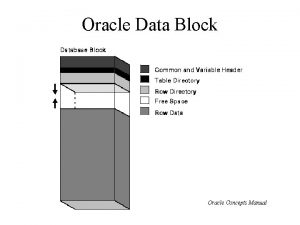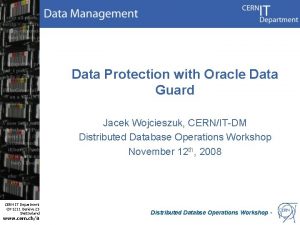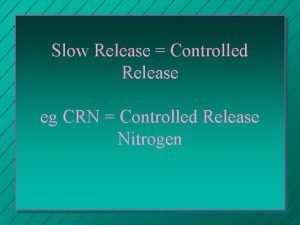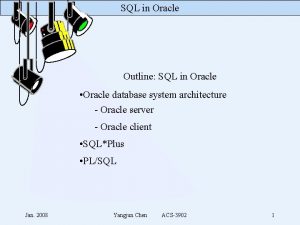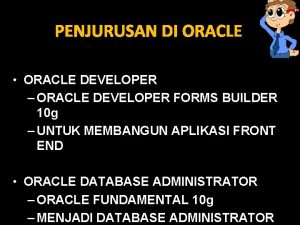Oracle Data Guard 11 g Release 2 with
































































- Slides: 64

Oracle Data Guard 11 g Release 2 with Oracle Enterprise Manager 11 g Grid Control

Oracle Data Guard 11 g Release 2 with Oracle Enterprise Manager 10 g Grid Control �Introduction to High Availability �Data Guard Concepts �Managing Data Guard with OEM �Setup Data Guard without OEM

Introduction to High Availability � Availability is the degree of accessibility of an application, service or system. It is measured as the percentage of uptime in a given year. � Characteristics of a highly available systems o o o Reliability Resiliency No single point of failure (SPOF) Recoverability Timely error detection Continuous operation

Introduction to High Availability Finalize with all stake holders prior to DR planning and implementation � Service Level Agreement (SLA): agreement between two parties specifying levels of availability, performance or operation. In the contract the level of each service should be clearly defined. � Recovery Time Objective (RTO): maximum amount of time that application, service or system can be down before the organization starts suffering unacceptable consequences. � Recovery Point Objective (RPO): maximum amount of data that can be lost without harm to the organization as a result from failure of an application, service or system.

Introduction to High Availability Resiliency and protection from failures Unplanned � Site failure � Cluster failure � Computer failure � System failure � Storage failure � Data corruption � Human error � Hang or slowdown � Natural disaster Planned � System and database changes � Data changes � Application changes

Introduction to High Availability � Present demand for high availability � Oracle HA solutions as response �Oracle RAC �Oracle Data Guard �Oracle Flashback �Oracle Streams �Oracle Goldengate � How we benefit leveraging Oracle RAC, Oracle Data Guard and Oracle Flashback implementing MAA? � How Oracle RAC, Oracle Data Guard, Oracle Flashback work in tandem in implementing MAA solutions. �Data Guard Configurations �Fast Start failover �Flashback as a way to avoid restoring the primary from backup in case of a failover, converting it to standby and synching it with the new primary. � OEM as a primary tool for managing MAA solutions.

Data Guard Concepts �Oracle Data Guard provides the managements, monitoring and automation software to create and maintain one or more standby databases to protect Oracle data from failures, disasters, human errors and data corruption �Data Guard configuration consist of one primary database and one or more standby databases. The databases in a Data Guard configuration may be dispersed geographically. �Managing primary and standby databases can be done using SQL command-line interfaces, Data Guard broker interfaces or using a GUI interface provided with OEM Grid Control.

Data Guard Concepts �Primary database: accessed by most applications, can be a single instance or RAC database �Standby database: consistent copy of the primary database. Maintained automatically using redo data. Can be a single-instance or RAC database.

Data Guard Concepts • • • 1. 2. 3. Physical Standby database Provides a block-for-block physically identical copy of the primary database. Synchronized through Redo Apply. Redo records are shipped and applied to the standby database. Benefits: Switchover and failover Standby database can be open in read only mode while redo apply continues ( Active data Guard). Can not be used when with reporting tools requiring read-write access such as repository creation. Can be used as a robust DR implementation. • • • 1. 2. 3. Logical Standby database Provides a logically (transactionally) identical copy of the primary database. Contains the same logical information as the primary database although the physical organization and structure can be different. Synchronized via SQL Apply. Redo records are shipped to the standby database and mined and applied as a SQL to the standby database. Additional structures can be created to optimize the reporting workload. Some restrictions on data types, types of tables and types of DDL and DML operations. Benefits: Switchover and failover Standby database open in read-write mode. Offload production when apps need read-write access but do not modify primary data such as when repositories are created. Can be used to perform upgrades to primary database with near zero downtime.

Data Guard Concepts �Switchover : the primary database transition to a standby role and the standby database transition to the primary role. It is used during the course of a planned maintenance of the primary database and ensure no data loss. Final EOR is applied on the standby database. �Failover: Occurs when the primary database is unavailable. Failover is performed only in case of a failure of the primary database and the failover results in a transition of a standby database to the primary role. Final EOR is not applied on the standby database.

Data Guard Concepts Maximum availability: Archive destination is mandatory with log writer sync and affirm. Set by ‘alter database set standby to maximize availability’. Transactions do not commit until all redo data needed to recover the transactions has been written to the online redo log and to the standby redo log on at least one synchronized standby database. Ensures zero data loss except in case of certain failures when standby can not receive redo from primary. � Maximum performance: Archive destination is either mandatory/optional and transport is log writer or archive process and synchronous or asynchronous. Set by ‘alter database set standby to maximize performance’. Is the default protection mode. Transactions commit as soon as redo data generated by those transactions has been written to the online log. Offers less data protection than maximum availability mode. � Maximum protection: Archive destination is mandatory with log writer sync and affirm. Set by ‘alter database set standby to maximize protection’. Redo data needed to recover as a transaction must be written to both the online redo log and to the standby database redo log on at least one synchronized standby database before the transaction commits. Ensures zero data loss. �

Data Guard Concepts • • • New features in 11 g. R 1 Support up to 9 standby databases. Real time query capability of physical standby database (New Active Data Guard) feature. User configurable conditions to initiate faststart failover. New Snapshot Data Guard feature. Transport of redo data using SSL Support of TDE with Data Guard SQL Apply. • • New features in 11 g. R 2 Support up to 30 standby databases. Integrated support for Application failover. Compressed table support in logical standby databases. Automatic redo corruption detection and repair.

Data Guard Concepts Lets put it together…

Managing Data Guard with OEM Add physical or logical standby database. � � Crate a new physical or logical standby database � Add an existing standby database for management with Data Guard Broker. � Flexible options for creating standby databased on RMAN features for backup and cloning. � Direct cloning using the primary database as a source. � Using a staged backup � Created with create standby database wizard � Created as level 0 and level 1 regular backup � Monitor performance of a standby database � � � � � Redo Generation Rate Redo Apply Rate Transport Lag Apply Lag Monitor the archiving and application of redo log Verify structure of a Data Guard Perform Switchover or Failover Set the type of a standby database (Active Data Guard & Snapshot Data Guard) Manage a Data Guard configuration and set fast-start failover.

Managing Data Guard with OEM �Add physical or logical standby database.

Managing Data Guard with OEM �Add physical standby database.

Managing Data Guard with OEM �Add physical standby database.

Managing Data Guard with OEM �Add physical standby database.

Managing Data Guard with OEM �Add physical standby database.

Managing Data Guard with OEM �Add physical standby database.

Managing Data Guard with OEM �Add physical standby database.

Managing Data Guard with OEM �Add physical standby database.

Managing Data Guard with OEM �Add physical standby database.

Managing Data Guard with OEM �Add physical standby database.

Managing Data Guard with OEM � Add physical standby database. ◦ ◦ After adding a standby database new options under Data Guard hyperlink appears What we gain?

Managing Data Guard with OEM �Verify structure of a Data Guard

Managing Data Guard with OEM Verify structure of a Data Guard What OEM do for us? � What we need to do if we do it ourselves? � Initializing Connected to instance oel 55. gj. com: D 11 P Starting alert log monitor. . . Updating Data Guard link on database homepage. . . Skipping verification of fast-start failover static services check. Data Protection Settings: Protection mode : Maximum Performance Redo Transport Mode settings: D 11 P: ASYNC D 11 P 1: ASYNC Checking standby redo log files. . . OK Checking Data Guard status D 11 P : Normal D 11 P 1 : Normal Checking inconsistent properties Checking agent status Checking applied log on D 11 P 1. . . OK Processing completed.

Managing Data Guard with OEM �Monitor performance of a standby database

Managing Data Guard with OEM �Monitor performance of a standby database

Managing Data Guard with OEM �Manage a Data Guard configuration

Managing Data Guard with OEM �Manage a Data Guard configuration

Managing Data Guard with OEM �Manage a Data Guard configuration

Managing Data Guard with OEM �Manage a Data Guard configuration

Managing Data Guard with OEM �Manage a Data Guard configuration

Managing Data Guard with OEM �Manage a Data Guard configuration – Perform a switchover

Managing Data Guard with OEM �Manage a Data Guard configuration – Perform a Failover

Managing Data Guard with OEM �Manage a Data Guard configuration – Perform a Failover

Managing Data Guard with OEM �Manage a Data Guard configuration – Perform a Failover & Reinstate the old physical database

Managing Data Guard with OEM �Manage a Data Guard configuration – Perform a Failover & Reinstate the old physical database

Managing Data Guard with OEM �Manage a Data Guard configuration – Configure fast-start failover o o o Select a standby database as a target for the faststart failover Configure observer ( specify observer host and observer ORACLE_HOME) Set failover properties Enable flashback logging Enable observer Fast start failover does NOT work in maximum protection role. In 10 g only max availability role was supported for FSFO. Since 11 g both maximum performance and maximum availability are supported.

Managing Data Guard with OEM �Manage a Data Guard configuration – Configure Observer

Managing Data Guard with OEM �Manage a Data Guard configuration – Enable flashback logging

Managing Data Guard with OEM �Manage a Data Guard configuration – complete fast-start failover configuration

Managing Data Guard with OEM �Manage a Data Guard configuration – complete fast-start failover configuration

Managing Data Guard with OEM � Manage a Data Guard configuration – Create logical standby database • • • Specify ‘Create new logical standby database’ and follow similar steps as create a physical standby database. SQL Apply Unsupported tables Specify Backup options Specify Database location Specify File locations Specify Configuration

Managing Data Guard with OEM �Manage a Data Guard configuration – Create logical standby database �SQL Apply Unsupported tables

Managing Data Guard with OEM �Manage a Data Guard configuration – Create logical standby database

Managing Data Guard with OEM �Monitor a Data Guard configuration

Managing Data Guard with OEM �Monitor a Data Guard configuration �Redo logs archived and applied

Managing Data Guard with OEM � Active Data Guard �What is Active Data Guard? �How to set Active Data Guard?

Managing Data Guard with OEM Snapshot Data Guard � � What is Snapshot Data Guard? � How to set Snapshot Data Guard? � Set Redo Transport Off � Enable Flash back Database � Set Redo Transport On � Use Convert to toggle between Snapshot Database and Physical Database

Managing Data Guard with OEM Manage a Data Guard configuration – Add existing Data Guard with OEM • Configuring Data Guard Broker with OEM Grid Control to manage an existing Data Guard by enabling Data Guard Broker • Select ‘Add standby database screen’ • Specify the standby database to be enabled for management with Data Guard Broker and specify the additional properties (login credentials, archive destination, FRA). • Review the changes and confirm the creation of a Data Guard Broker configuration enabling us to manage the database via OEM or DGMGRL.

Managing Data Guard with OEM Manage a Data Guard configuration – Remove Data Guard configuration • Removing a standby database from Data Guard Broker. • Select a standby database you want removed from the Data Guard configuration • Press REMOVE button. • Acknowledge that you want to remove it at the confirmation page (database remains on ASM or disk). • Remove a Data Guard configuration • Click at the ‘Remove Data Guard Configuration’ link • Acknowledge that you want to remove the configuration at the confirmation page. • When complete you are returned to the Data Guard home page.

Managing Data Guard without OEM Setup Data Guard without OEM �Configure primary database �Configure Oracle NET �Prepare standby site �Create directory structures on the standby site �Copy password file from primary database �Create init file �Set-up environment variables on the standby site �Create the standby database using the new 11 g RMAN feature for duplicating a database using an active primary database. �Verify that the standby database is correct and redo data is received and archived on the standby database. �Create a data Guard Broker configuration using DGMGRL utility

Managing Data Guard without OEM Configure primary database �Make sure the primary database has a spfile; �Enable force logging on primary: SQL> alter database force logging; �Configure database to have standby redo logs on primary: SQL> alter database add standby logfile; �Configure database initialization parameters LOG_ARCHIVE_CONFIG and LOG_ARCHIVE_DEST_n on primary: SQL>alter system set log_archive_config=’dg_config=(d 11 p, d 11 s)’; SQL>alter system set log_archive_dest_2=’service=d 11 s ASYNC valid_for=(ONLINE_LOGFILE, PRIMARY_ROLE) db_unique_name=d 11 s’; �Configure the primary database in ARCHIVELOG mode SQL> alter database arhivelog;

Managing Data Guard without OEM Configure Oracle NET Create an alias for the standby in tnsnames. ora ◦ D 11 S = ◦ (DESCRIPTION = ◦ (ADDRESS_LIST = ◦ (ADDRESS = (PROTOCOL = TCP)(HOST = oel 55. gj. com)(PORT = 1521)) ◦ (CONNECT_DATA = ◦ (SERVER = DEDICATED) ◦ (SERVICE_NAME = D 11 S) ◦ ) � � On the standby site configure an entry for the standby database in listener. ora ◦ SID_LISTENER = ◦ (SID_LIST = ◦ (SID_DESC = ◦ (GLOBAL_DBNAME = D 11 S) ◦ (ORACLE_HOME = /u 01/app/oracle/product/11. 2. 0/db_1 ) ◦ (SID_NAME = D 11 S) ◦ ) �

Managing Data Guard without OEM Prepare Standby site for D 11 S standby database �Create the directories required for the standby database D 11 S. �Copy the orapw from the primary site and rename it to orapw. D 11 S to match the name of the standby instance. �Create init. D 11 S. ora with a line db_name=D 11 S �Set environment variables. �Start the standby database in nomount using the init. D 11 S. ora

Managing Data Guard without OEM Run RMAN to create the standby database D 11 S from D 11 P On the primary site: � Run RMAN for creating the standby database � rman target / auxiliary sys@D 11 S � execute the script: run { allocate channel d 11 gp 1 type disk; allocate channel d 111 p 2 type disk; allocate auxiliary channel stby type disk; duplicate target database for standby from active database spfile parameter_value_convert ‘d 11 p, d 11 s’ set db_unique_name=’d 11’ set db_file_name_convert=’/d 11 p/’, ’/d 11 s/’ set log_archive_max_processe=’ 5’ set fal_client=’d 11 s’ set fal_server=’d 11 p’ set standby_file_management=’AUTO’ set log_archive_config=’dg_config=(d 11 p, d 11 s)’ set log_archive_dest_2=’service=d 11 p SYNC valid_for=(ONLINE_LOGFILE, PRIMARY_ROLE) db_unique_name=d 11 p’; }

Managing Data Guard without OEM Verify the standby database creation. Make sure redo is received and archived on standby � On the standby database check the sequence# of the last received log by issuing: SQL> select sequence#, first_time, next_time, applied from v$archive_log order by sequence#; � Perform a log switch on the primary SQL> alter system switch logfile; � Check if the log is received and archived on the standby site by verifying that the sequence is increments by one. SQL> select sequence#, first_time, next_time, applied from v$archive_log order by sequence#;

Managing Data Guard without OEM Create a data Guard Broker configuration using DGMGRL utility � Set the DG_BROKER_START=TRUE on both primary and standby database SQL> alter system set dg_broker_start=true; � Modify the listener to work with Data Guard Broker by adding a static entry for DGMGRL to avoid ORA-12154 errors. Errors can be observed on startup of the standby database after performing a switchover. Reload the listener. SID_LISTENER = (SID_LIST = (SID_DESC = (GLOBAL_DBNAME = D 11 P_DGMGRL) (ORACLE_HOME = /u 01/app/oracle/product/11. 2. 0/db_1 ) (SID_NAME = D 11 P) ) (SID_DESC = (GLOBAL_DBNAME = D 11 S_DGMGRL) (ORACLE_HOME = /u 01/app/oracle/product/11. 2. 0/db_1 ) (SID_NAME = D 11 S) ) ) � Invoke the DGMGRL and connect to the primary database. Create the Data Guard Broker configuration that includes a profile for the primary database. DGMGRL>create configuration ‘DR 1’ as primary database is ‘D 11 P’ connect identifier is D 11 P; � Add the physical standby database to the broker configuration. DGMGRL>add database ‘D 11 S’ as connect identifier is D 11 S; � Enable the configuration. DGMGRL> enable configuration; � Verify the configuration. DGMGRL> show configuration;

Managing Data Guard without OEM Create a data Guard Broker configuration using DGMGRL utility How to setup Active Data Guard? � On the standby database perform: DGMGRL> edit database ‘D 11 S’ set state=’apply-off’; SQL>alter database open read only; DGMGRL>edit database ‘D 11 S’ set state=’apply-on’; �

Managing Data Guard without OEM Create a data Guard Broker configuration using DGMGRL utility �How to enable Fast start failover? �Enable flashback on the primary and standby databases �Verify we configured standby redo log files �Ensure the Log. Xpt. Mode Property is set to SYNC. These commands will succeed only if database is configured with standby redo logs. DGMGRL> EDIT DATABASE D 11 P SET PROPERTY 'Log. Xpt. Mode'='SYNC'; DGMGRL> EDIT DATABASE D 11 S SET PROPERTY 'Log. Xpt. Mode'='SYNC'; �Specify the Fast. Start. Failover. Target property DGMGRL> EDIT DATABASE D 11 P SET PROPERTY Fast. Start. Failover. Target='D 11 S'; DGMGRL> EDIT DATABASE D 11 S SET PROPERTY Fast. Start. Failover. Target='D 11 P';

Managing Data Guard without OEM Create a data Guard Broker configuration using DGMGRL utility � How to enable Fast start failover? (cont. ) �Make sure maximum protection is not set. �Enable Fast Start Failover DGMGRL>enable fast_start failover �Verify configuration DGMGRL>show fast_start failover DGMGRL>show database D 11 P DGMGRL>show database D 11 S �Perform switchover to the standby database DGMGRL>switchover to D 11 S; �Check changes to the configuration DGMGRL>show configuration; SQL> select database_role from v$database; �Perform switchover to the original primary DGMGRL>switchover to D 11 P; �Check changes to the configuration DGMGRL>show configuration; SQL> select database_role from v$database;

Oracle Data Guard 11 g Release 2 with Oracle Enterprise Manager 11 g Grid Control Questions?
 Affirm and noaffirm in oracle data guard
Affirm and noaffirm in oracle data guard Oracle coast guard
Oracle coast guard Oracle maximum availability architecture
Oracle maximum availability architecture Oracle data guard far sync
Oracle data guard far sync Active data guard in oracle
Active data guard in oracle Difference between sustained release and controlled release
Difference between sustained release and controlled release Extended release vs sustained release
Extended release vs sustained release Extended release vs sustained release
Extended release vs sustained release Upper hood guard and full diameter saw guard
Upper hood guard and full diameter saw guard Osha power tools must be fitted with guards and
Osha power tools must be fitted with guards and Oracle release management
Oracle release management Oracle apex ecommerce
Oracle apex ecommerce Vietnam national space center
Vietnam national space center Ncq greenwich
Ncq greenwich Data guard
Data guard Data guard concepts
Data guard concepts Oracle data archiving
Oracle data archiving Sql
Sql Oracle master data
Oracle master data Data integrity in oracle
Data integrity in oracle No data found exception in oracle
No data found exception in oracle Total recall oracle
Total recall oracle Vb.net nvl
Vb.net nvl Restricting and sorting data in oracle
Restricting and sorting data in oracle Data warehouse modeling best practices
Data warehouse modeling best practices Unifying healthcare data
Unifying healthcare data Oracle big data sql
Oracle big data sql Oracle replication
Oracle replication Qc control integrator
Qc control integrator Stimulus of erythropoiesis
Stimulus of erythropoiesis Web telex
Web telex Telex release
Telex release Telex release b/l
Telex release b/l Tv release form
Tv release form Pressure and release model
Pressure and release model Advantages and disadvantages of dosage forms pdf
Advantages and disadvantages of dosage forms pdf Sustained release
Sustained release Vsts octopus deploy
Vsts octopus deploy What is the formula for latent heat
What is the formula for latent heat I = p r t
I = p r t Myofascial release salisbury
Myofascial release salisbury Sandalwood orientation
Sandalwood orientation 3:1 rope system
3:1 rope system Ricas released items grade 3
Ricas released items grade 3 Release manager roles and responsibilities
Release manager roles and responsibilities John pushes hector on a plastic toboggan
John pushes hector on a plastic toboggan Press release distribution
Press release distribution Struktur press release
Struktur press release Montgomery county pre release center
Montgomery county pre release center How to release emotions trapped in your body
How to release emotions trapped in your body Press release subhead
Press release subhead Science olympiad gravity vehicle ramp
Science olympiad gravity vehicle ramp Staar grade 6 reading 2016 released
Staar grade 6 reading 2016 released Pressure and release model
Pressure and release model Experimental study of hydrogen release and ignition from
Experimental study of hydrogen release and ignition from Bonding continuum
Bonding continuum Feature of contemporary dance
Feature of contemporary dance How does atp release energy
How does atp release energy Indication and contraindication of mobilization
Indication and contraindication of mobilization Equilibrium bond distance
Equilibrium bond distance Arena basic process
Arena basic process Ace cargo release
Ace cargo release Aprv indications
Aprv indications Maintenance release statement
Maintenance release statement Energy release component
Energy release component
